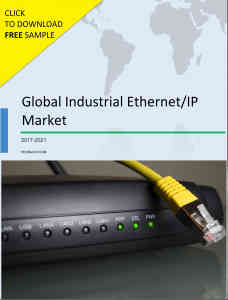From a network that was used to connect official workstations to a technology that is deployed to monitor and control the systems in the manufacturing space, Ethernet/IP technology has grown by leaps and bounds within the past decade. Today, ethernet networks are the primary solutions for industrial automation applications, thanks to their ability to enhance productivity, even under the harshest and most challenging work conditions.
While many other automation sectors have witnessed little to no growth over the past few years, industrial ethernet devices market continues to post significant growth. The industrial ethernet connectors are being embraced by several organizations mainly due to the former’s emerging status as the network workhorse for communication-enabled approaches such as the Industrial Internet of Things (IIoT) and Industries 4.0.
 The big picture benefits of industrial ethernet technology as often touted by analysts and vendors pertains to quick response- in cases of incrementing market demand and to glitches witnessed during production runs. Additionally, greater flexibility and high-speed performance completes the equation.
The big picture benefits of industrial ethernet technology as often touted by analysts and vendors pertains to quick response- in cases of incrementing market demand and to glitches witnessed during production runs. Additionally, greater flexibility and high-speed performance completes the equation.
Why are industries embracing the Ethernet/ IP?
In the past decade, the rate of ethernet adoption in industrial operations has quadrupled, owing to its greater flexibility, high-speed performance and other associated benefits. Using Industrial Ethernet/IP technology in the manufacturing space enables factory devices to stay connected to a business’s existing system in order to gain a higher level of insights into the company’s core operations.
In today’s world, rapid industrial growth has prompted industry owners to adopt automation in every layer and stage, starting from assembling the raw materials to packaging. In terms of the producer-consumer services, the ethernet protocol supports prioritization of messages and multiple communication hierarchies. These services are inclined to improve the efficiency of the use of bandwidth and eventually outperform big name networks.
Emergence of Ethernet/IP linking devices
Thanks to the current infrastructure setup of Ethernet/IP technology, the communication networks can accommodate an unlimited number of devices. The industrial ethernet is mainly designed for interoperability among different industrial applications and layers. Ethernet/IP has the proficiency of linking seven different layers, including data link, network, physical, session, presentation, transportation, and application, during operations in the industry.
The linking of devices between the existing PROFIBUS, Modbus-TCP, and Serial Linking technology to the ethernet/IP networks is gaining popularity owing to their capability of transferring data at high speeds. These networks can handle 7,000 bytes of input/output data, irrespective of their pattern of flow, cyclic or acyclic.
They even reduce the additional efforts needed for calculating the PLC connected to the network. They transfer data between the two networks in complete transparency and act as a slave to the ethernet/IP network and a powerful master on the PROFIBUS side.
In the manufacturing space today, the rapid transmission of data over TCP/IP from the front office to the manufacturing plants has the potential to transform how products are produced. Interoperability between product designs, the machines and workflow systems will trim down time-to-market, and the same competence will increase the number of product variations conceivable in a manufacturing plant.
Industrial Internet of Things: Shaping the communication network trends
Almost every industry today is refurbishing its infrastructure by employing Internet of Thing (IoT). IIoT is a network of smart devices, such as sensors, controllers, machines, cloud computing and big data analytics. Such a connection can link data analytics with the operations of industrial automation, which could eventually advance the application designs of the associated industry.
Nowadays, several manufacturers find ethernet/IP to be more beneficial when connected with automation, as it delivers a greater bandwidth and is constantly upgraded with technological advancements. The major reason for the preference for ethernet/IP in IIoT automation is that the latter is highly compatible and can incorporate CIP (Common Industrial Protocol).
The versatile role of Ethernet networks in IIoT
Industrial Internet of Things (IIoT) enabled with ethernet/IP-based devices apparently results in the development of smart factories, which ultimately leads to an increase in productivity, throughput, and reduction in inventory. Plus, this will also reduce the maintenance costs, enabling the manufacturers to save on scheduled repairs, maintenance and also eliminate breakdowns.
To live up to these lofty expectations and requirements, IIoT must be capable of sending data from process tools to higher level platforms including enterprise resource planning applications and asset management systems. In this line, ethernet based networks have a distinct technical advantage over their Fieldbus predecessors.
However, there are few other things to consider including vendor support and application requirements while selecting a suitable protocol for a given situation.
Overall, numerous existing vendors are expanding their industrial ethernet offerings while a surge of new entrants continue to take benefit of the growth opportunities in this fast-evolving industry. The game, is very much on!



